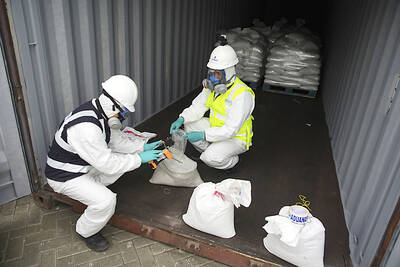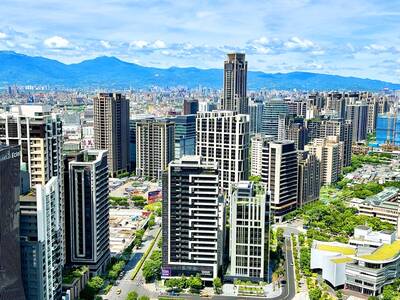A new sense of optimism surrounded WTO negotiations on a new global trade pact yesterday amid hopes of a breakthrough after seven years of deadlock.
Key dealmakers said most of the 35 leading trading nations meeting have bridged their differences, but fears remained that emerging market countries India and Argentina could ruin the upbeat mood.
“I think the situation looks strong. I think we can be very hopeful now,” said European Trade Commissioner Peter Mandelson as he left talks late on Friday.
“What is emerging is a deal that is not perfect, not beautiful, but is good for the global economy and good for development.”
Ministers from 35 leading economies have been meeting all week to discuss reductions in subsidies and import tariffs with the aim of mapping out a new free-trade deal, called the Doha Round, to boost world commerce.
The Doha Round was launched in the Qatari capital seven years ago, but has foundered because of disputes between the rich developed world and poorer developing nations on trade in farm and industrial products.
Despite the optimism — in stark contrast with a feeling on Friday that talks faced imminent collapse — the US warned that a handful of countries could still torpedo the goodwill.
“There are a handful of large emerging markets that quite frankly risk unraveling the entire package,” said US Trade Representative Susan Schwab in reference to a draft agreement under discussion.
She added, however, that while there was “more work to do, it is a path forward.”
Argentina said it would be unwilling to accept the proposed agreement as it stands and diplomatic sources said that India was also standing in the way of progress.
Indian Commerce Minister Kamal Nath has insisted all week that he will protect his country’s millions of subsistence farmers and nascent industry, which are shielded from imports by tariffs levied on foreign goods.
“There is no agreement but there are certain areas of concerns, certain areas of consensus,” he said late on Friday.
Mandelson said India would eventually come on board, telling reporters: “I don’t think India will be the one to break a world trade round. I really don’t.”
The talks on Friday focused on trade in farm and industrial products — the two main sticking points of a deal — but attention was set to turn yesterday to the services sector.
Talks are set to overrun their original program, which foresaw an end yesterday, and continue throughout the weekend and early into the week, sources said.
“There is a convergence among the seven [leading powers] on several key figures for agriculture and industrial products,” said Brazil’s trade negotiator, Foreign Minister Celso Amorim.
“My opinion is that the chances of reaching an accord have risen to 65 percent from 50 percent,” he added.
The marked turnaround on Friday emerged after meetings between seven key trading powers — the US, the EU, Australia, Brazil, China, India and Japan — which finally made progress after five days of deadlock.
The talks then widened to a ministerial conference of all 35 key nations invited to Geneva to broker the pact.
Anything approved by the 35 parties would still have to be cleared by all 153 WTO member states. A new pact can only be adopted with unanimity.
WTO Director-General Pascal Lamy had warned earlier on Friday that the talks faced failure unless countries showed flexibility and determination.
Among new proposals he put forward on Friday was a further cut in the US annual farm subsidies to US$14.5 billion and a clause to prevent developing countries from shielding entire sectors from tariff cuts, a source said.
Diplomats and negotiators had said that Friday would be make-or-break at the end of grueling week of bargaining that had produced scant evidence of progress.
“No one is happy with every detail that’s in the direction forward today. But there is acceptance I think, in the main, that ... it’s the basis for moving forward,” said Australian Trade Minister Simon Crean.
However the Australian minister cautioned that the package could only be accepted on a “take it or leave it” basis.
“It has to be accepted in the totality, not trying to pick apart aspects of the detail,” he said. “I think that’s the spirit in which people wanted to proceed. Today was a very significant advance.”

The seizure of one of the largest known mercury shipments in history, moving from mines in Mexico to illegal Amazon gold mining zones, exposes the wide use of the toxic metal in the rainforest, according to authorities. Peru’s customs agency, SUNAT, found 4 tonnes of illegal mercury in Lima’s port district of Callao, according to a report by the non-profit Environmental Investigations Agency (EIA). “This SUNAT intervention has prevented this chemical from having a serious impact on people’s health and the environment, as can be seen in several areas of the country devastated by the illegal use of mercury and illicit activities,”

NEW PRODUCTS: MediaTek plans to roll out new products this quarter, including a flagship mobile phone chip and a GB10 chip that it is codeveloping with Nvidia Corp MediaTek Inc (聯發科) yesterday projected that revenue this quarter would dip by 7 to 13 percent to between NT$130.1 billion and NT$140 billion (US$4.38 billion and US$4.71 billion), compared with NT$150.37 billion last quarter, which it attributed to subdued front-loading demand and unfavorable foreign exchange rates. The Hsinchu-based chip designer said that the forecast factored in the negative effects of an estimated 6 percent appreciation of the New Taiwan dollar against the greenback. “As some demand has been pulled into the first half of the year and resulted in a different quarterly pattern, we expect the third quarter revenue to decline sequentially,”

DIVERSIFYING: Taiwanese investors are reassessing their preference for US dollar assets and moving toward Europe amid a global shift away from the greenback Taiwanese investors are reassessing their long-held preference for US-dollar assets, shifting their bets to Europe in the latest move by global investors away from the greenback. Taiwanese funds holding European assets have seen an influx of investments recently, pushing their combined value to NT$13.7 billion (US$461 million) as of the end of last month, the highest since 2019, according to data compiled by Bloomberg. Over the first half of this year, Taiwanese investors have also poured NT$14.1 billion into Europe-focused funds based overseas, bringing total assets up to NT$134.8 billion, according to data from the Securities Investment Trust and Consulting Association (SITCA),

Taiwan’s property transactions in the first half of this year fell 26.4 percent year-on-year to about 130,000 units, as credit controls and mortgage restrictions dampened demand, data from the Ministry of the Interior showed yesterday. Keelung saw the steepest decline, with transactions plummeting 45.6 percent to just 2,041 units — the lowest since the ministry began its survey in 2006. In contrast, Miaoli County was the only region to experience year-on-year growth, with transactions rising 2.4 percent to 3,229 units. Great Home Realty Co (大家房屋) attributed the increase in deals in Miaoli, particularly Jhunan (竹南) and Toufen (頭份) townships, to spillover demand